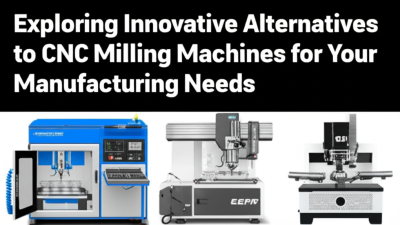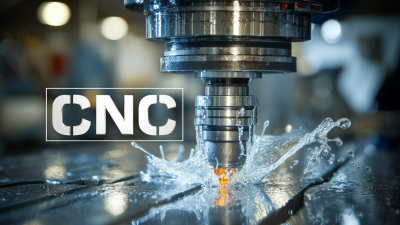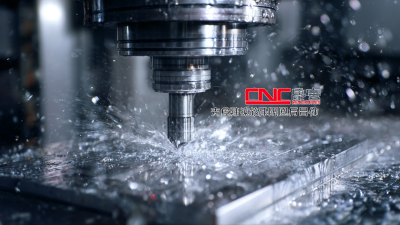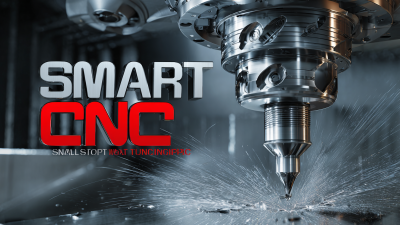Unlocking Precision: How CNC Machines Revolutionize Manufacturing with 30% Efficiency Gains
In the modern landscape of manufacturing, the advent of CNC machines has dramatically transformed production processes, unlocking a new realm of precision and efficiency. These computer numerical control devices enable businesses to automate intricate machining tasks, resulting in substantial efficiency gains, often exceeding 30%. This shift not only enhances productivity but also minimizes human error, leading to superior quality in the final products.

In this article, we will explore various strategies and best practices on how to effectively implement CNC machines in your manufacturing operations. By leveraging these advanced tools, companies can streamline workflows, optimize material usage, and ultimately achieve significant cost savings. Join us as we delve into the world of CNC machining and discover how you can harness its potential to revolutionize your manufacturing processes.
Understanding CNC Machines: Key Components and Functionality
 CNC (Computer Numerical Control) machines have become integral to modern manufacturing processes, significantly enhancing efficiency and precision. Understanding the key components and functionality of CNC machines is essential for anyone involved in the industrial sector. At the core of CNC technology are four main components: the control unit, drive motors, feedback systems, and the machine itself. The control unit interprets the coded instructions and sends signals to the motors, which in turn move the machine's tools with remarkable precision.
CNC (Computer Numerical Control) machines have become integral to modern manufacturing processes, significantly enhancing efficiency and precision. Understanding the key components and functionality of CNC machines is essential for anyone involved in the industrial sector. At the core of CNC technology are four main components: the control unit, drive motors, feedback systems, and the machine itself. The control unit interprets the coded instructions and sends signals to the motors, which in turn move the machine's tools with remarkable precision.
Tips: When considering the integration of CNC machines into your manufacturing processes, focus on training your operators thoroughly. A well-trained workforce can maximize the machine's capabilities and ensure safe operation. Additionally, regular maintenance is crucial; keep a schedule to maintain components to extend the lifespan of your CNC equipment.
As the CNC machine market continues to grow, projected to reach a staggering $229.46 billion by 2032, it's vital for companies to stay ahead of technological advancements. Keeping abreast of developments in CNC design and function will not only boost production efficiency but also enable manufacturers to remain competitive in an increasingly international market.
Identifying Efficiency Challenges in Traditional Manufacturing Methods
Traditional manufacturing methods often struggle with inefficiencies that hinder productivity and drive up costs. These methods typically rely on manual labor, which can lead to inconsistencies, longer production times, and higher error rates. Operators juggling multiple processes can easily misinterpret designs or make mistakes, resulting in wasted materials and labor.
Additionally, rigid manufacturing setups limit flexibility, making it challenging to adapt to changing demands or to implement design modifications quickly.
Moreover, traditional manufacturing often faces challenges in maintenance and downtime, as older machinery frequently requires repairs that can extend lead times. The lack of precise control and real-time data monitoring contributes to unexpected production halts, further disrupting workflow.
As competition increases and market demands evolve, these efficiency challenges become increasingly critical. Addressing these issues is essential to improving overall productivity and maintaining a competitive edge in an ever-evolving industry landscape.
Implementing CNC Technology for Enhanced Production Accuracy
 Implementing CNC technology in manufacturing processes has proven to be a
game-changer, particularly in enhancing
production accuracy. The integration of advanced CNC systems
allows manufacturers to achieve unprecedented levels of precision, significantly reducing the margin for error.
This transition from traditional machining to CNC methods not only streamlines operations but also enhances
product quality, making it a critical investment for businesses aiming to maintain a competitive edge.
Implementing CNC technology in manufacturing processes has proven to be a
game-changer, particularly in enhancing
production accuracy. The integration of advanced CNC systems
allows manufacturers to achieve unprecedented levels of precision, significantly reducing the margin for error.
This transition from traditional machining to CNC methods not only streamlines operations but also enhances
product quality, making it a critical investment for businesses aiming to maintain a competitive edge.
Furthermore, the significance of automated calibration systems in conjunction with CNC technology cannot be overstated. These systems ensure that measurement accuracy is consistently maintained, minimizing the reliance on manual calibration methods that can introduce variability. By marrying real-time data with digital models, manufacturers can anticipate and address potential discrepancies, leading to a seamless production flow. As the manufacturing landscape continues to evolve, embracing CNC technology and its associated innovations is essential for achieving enhanced accuracy and operational efficiency.
Measuring and Analyzing Efficiency Gains with CNC Machining
CNC machining has emerged as a cornerstone of modern manufacturing, significantly enhancing efficiency across various industries. According to a report by the International Federation of Robotics, the adoption of CNC machines has increased productivity levels by approximately 30%. This advancement is largely attributed to the precision and repeatability offered by CNC technology, which minimizes human errors and material waste. In facilities utilizing CNC machining, the precise control over cutting speeds and tool paths has allowed manufacturers to optimize their workflows, thereby reducing cycle times and improving output.
In measuring and analyzing these efficiency gains, various metrics are applied. For instance, the Machining Technology Association states that manufacturers using CNC machines experience an average reduction in production time by at least 40% compared to traditional machining techniques. This time savings not only translate into increased throughput but also enable firms to respond more flexibly to market demands. Moreover, the implementation of sophisticated CAM (Computer-Aided Manufacture) software further enhances efficiency by providing advanced planning tools that integrate seamlessly with CNC operations, facilitating a data-driven approach to performance analysis. Ultimately, the synergy between CNC technology and data analytics positions manufacturers to thrive in a competitive landscape.
| Manufacturing Process | Traditional Efficiency (%) | CNC Efficiency (%) | Efficiency Gain (%) |
|---|---|---|---|
| Milling | 70 | 90 | 28.57 |
| Turning | 65 | 85 | 30.77 |
| Drilling | 60 | 80 | 33.33 |
| Laser Cutting | 75 | 92 | 22.67 |
| 3D Printing | 58 | 75 | 29.31 |
Future Trends: Innovations in CNC Technology and Manufacturing Processes
The advent of CNC (Computer Numerical Control) technology has transformed manufacturing processes across various industries, particularly in the woodworking sector. By embracing advanced digital manufacturing techniques, businesses can achieve remarkable productivity improvements, with some reporting efficiency gains of up to 30%. This enhancement is largely driven by the demand for high precision and environmentally friendly operations, allowing suppliers to transition from traditional methods to automated solutions seamlessly.
As the market for CNC machinery continues to expand, it is crucial for manufacturers to stay abreast of emerging trends and innovations. For instance, hybrid CNC machining methods are gaining traction, enabling the production of high-quality wood products with unparalleled precision. Additionally, strategic collaborations among domestic technology giants are paving the way for a more robust industrial ecosystem, further bolstering the CNC market's growth trajectory.
**Tips:** When considering CNC technology for your operations, assess the long-term benefits of automation versus traditional methods. Emphasizing precision and sustainability can significantly enhance your brand's reputation in a competitive market. Moreover, staying informed about industry advancements can provide your business with a critical edge over competitors.
Unlocking Precision: CNC Machines Efficiency Gains
Related Posts
-

Shaping the Future of CNC Machines at the 138th Canton Fair in 2025
-

Exploring Innovative Alternatives to CNC Milling Machines for Your Manufacturing Needs
-

The Future of Advanced CNC Machine Technologies in Global Manufacturing
-

Unlocking Precision: The Key Advantages of CNC Milling Machines for Modern Manufacturing
-

Unmatched Excellence in Best CNC Metal from Leading Chinese Manufacturers
-

Discovering the Advantages of the Best Smart CNC Technology for Modern Manufacturing
 English
English  Česká republika
Česká republika Deutsch
Deutsch Dutch
Dutch Polska
Polska

